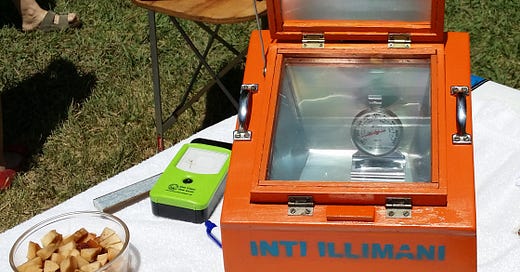Day 23: Learn How Improved Clean Cookstoves Save Lives and Cool the Planet
Plus a cook-along fundraiser
I have seen firsthand the importance of access to energy and clean cooking. It must play a central role in our work to ensure the realization of human needs and fundamental rights. — António Guterres, Secretary-General of the United Nations
Nearly one in three people on the planet cooks over open fires or outdated stoves, fueled by polluting wood principally but also charcoal, animal dung and agricultural waste. Because these fires and stoves burn inside people’s homes, families breathe in black carbon, carbon monoxide, carbon dioxide and methane, with women and girls affected the most, as they traditionally cook the family meals in many developing countries. Since 2014, this toxic indoor air pollution has been linked to nearly four million deaths each year.
In addition to greater health risks, women also miss out on opportunities to work or attend school, as some spend up to 20 hours or more every week gathering wood that can weigh up to 50 pounds, an exhausting physical endeavor.
A top solution to climate change
Cooking over wood exacerbates climate change in two ways—through deforestation driven by harvesting wood for fuel and by burning the harvested wood and generating emissions. Drawdown estimates these emissions account for from 2 to 5 percent of annual greenhouse gas emissions worldwide.
On its list of 100 solutions to global warming under two different scenarios—Scenario 1, with an increase of 2˚C in global temperatures by 2100 and Scenario 2, with an increase of 1.5˚C—Drawdown ranks improved clean cookstoves at number 7 and number 9 respectively.
Universal access to clean cookstoves would not only help mitigate climate change and prevent unnecessary deaths from pollution, it would also address gender and economic inequalities.
Nonprofits distributing clean cookstoves
Since the UN launched the Global Alliance for Clean Cookstoves in 2010, approximately 400 million people now cook with these cleaner technologies, which has prevented approximately 4.6 million deaths. Despite this progress, billions of people living in Africa, Asia and Latin America still rely on polluting stoves. (You can donate to Clean Cooking Alliance’s work here.)
I learned about another nonprofit that distributes stoves in developing countries—Solar Cookers International (SCI)—when I attended a solar cooking festival it sponsored several years ago in Sacramento on a sweltering summer day. Harnessing the power of the sun avoids all of the problems with open biomass fires and it provides people with a free way to pasteurize their drinking water.
According to Water.org, a child dies every two minutes from a water-related disease. Solar ovens make water contaminated with bacteria and viruses safe to drink. Water heated to 149°F (65°C) kills Hepatitis A. Heat it to 140°F (60°C), and it kills E.coli, Cholera and Typhoid bacteria and the Poliovirus. Worms and Cryptosporidium die at 131°F (55°C).
A WAPI (water pasteurization indicator), a small, less than 2-inch cylinder filled with wax, indicates when water has reached a high enough temperature to kill dangerous pathogens and render it drinkable. When the wax melts, the water has reached the point of pasteurization (which is lower than the boiling point of 212°F, or 100°C). The water might still be brown, but it will be safe to drink.
Giving solar cooking a try
“If you can see your shadow, you can cook.”
That’s what one of the solar cooking chefs told me at the festival. Pass this litmus test and a solar oven can make your dinner. Most of the ovens I saw at the festival had internal temperatures ranging from 200°F (93°C) to 250°F (121°C) , but some models reached temperatures of 400°F (204°C)!
Cooking with these ovens:
Reduces fossil fuel dependence
Has a benign environmental impact
Saves money (no gas bill)
Saves hands-on time—simply pop your food in the oven and leave it unattended
If you would like to build a solar cooker of your own, SCI offers a free guide here. The guide includes building instructions, activities for kids, tips and recipes for:
Rice
Pasta
Applesauce
Fish
Stewed tomatoes
Baked potatoes, squash and yams
Solar s’mores
Custard
Chili
“Refried” beans
Hard-boiled eggs
Whole wheat bread
Roasted nuts
And more!
Although I haven’t built my own solar oven yet, I have used a solar food dryer several times. It works well—and can reach up 200°F (93°C). I’ve dehydrated apple slices, tomato slices and kale chips. In 2020, I dehydrated tomatoes in the back windshield of my car during heatwave. And last summer, I dehydrated fruit under glass on the pavement. You can read more about those adventures here.
A Cook-Along and Fundraiser: Make Soup, Not Waste
So I couldn’t come up with a specific action for today and thought, why not do a clean cookstove fundraiser? Donate what you feel, we’ll meet online, make soup with whatever we all have on hand—don’t shop for this cook-along! All proceeds will go to Solar Cookers International. Make dinner, hang out and raise money for a good cause.
Date: Thursday, February 24, 4pm PT/7pm ET
Where: Zoom
Workshop materials: You’ll find the list of class materials on the registration page when you click the button below.
You can check out a few of my previous fundraisers here, here and here. I hope some of you can make it next month!





I just entered your fundraising cooking date in the Green Change Calendar https://www.greenchange.net/calendar/. Thanks so much for all your work on this 30 Days of Climate Action!
Never heard of these! World Vision may distribute??